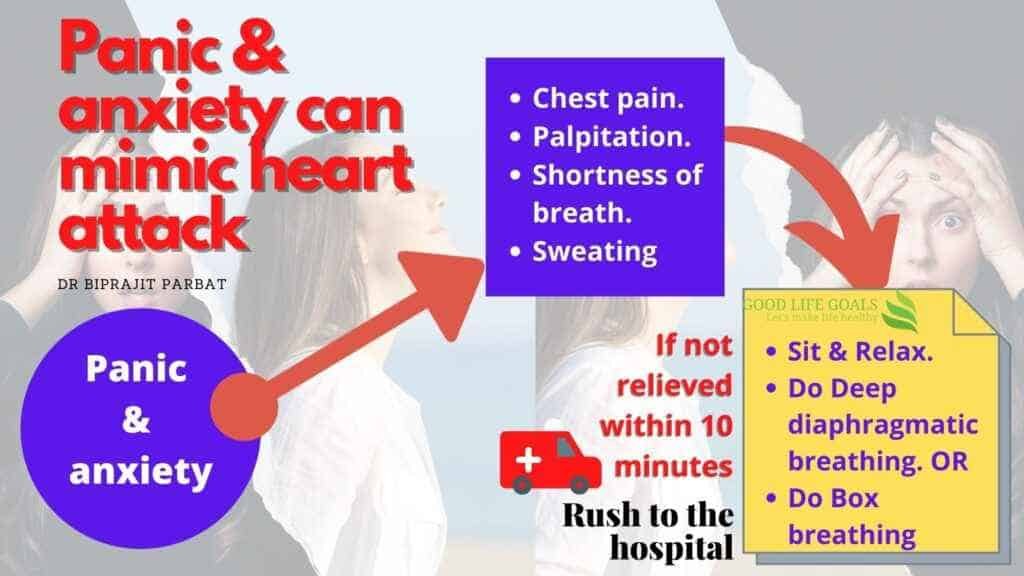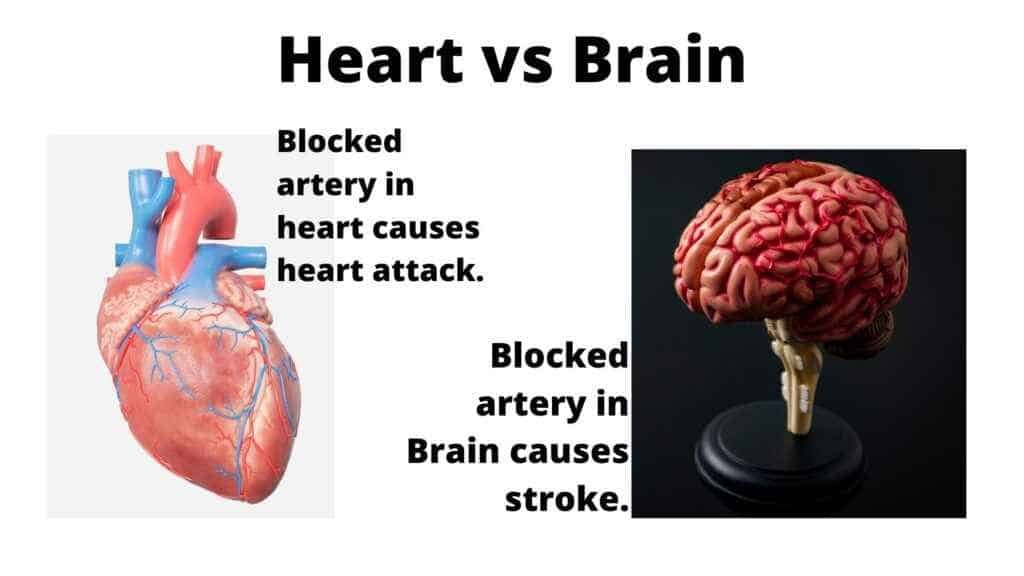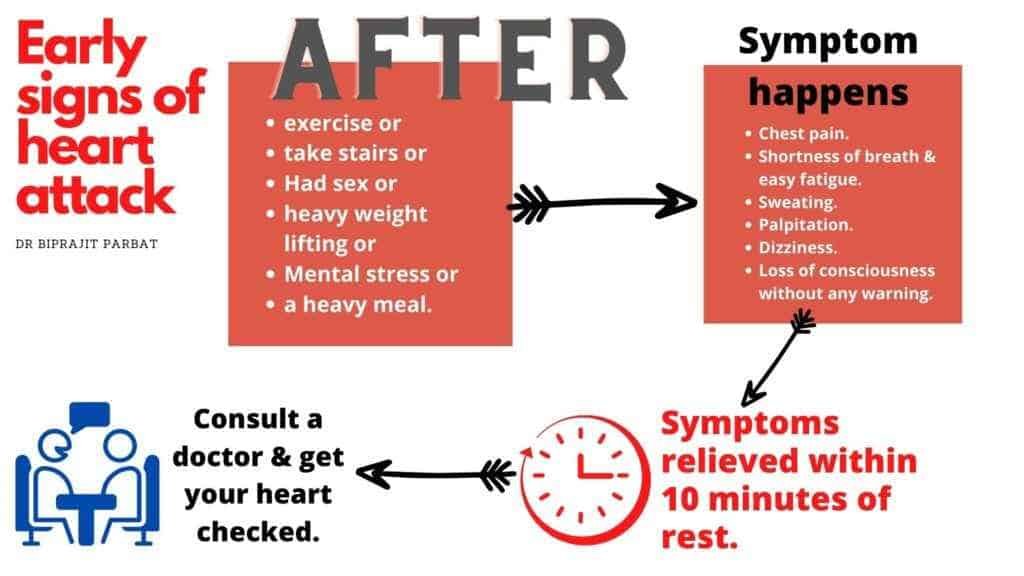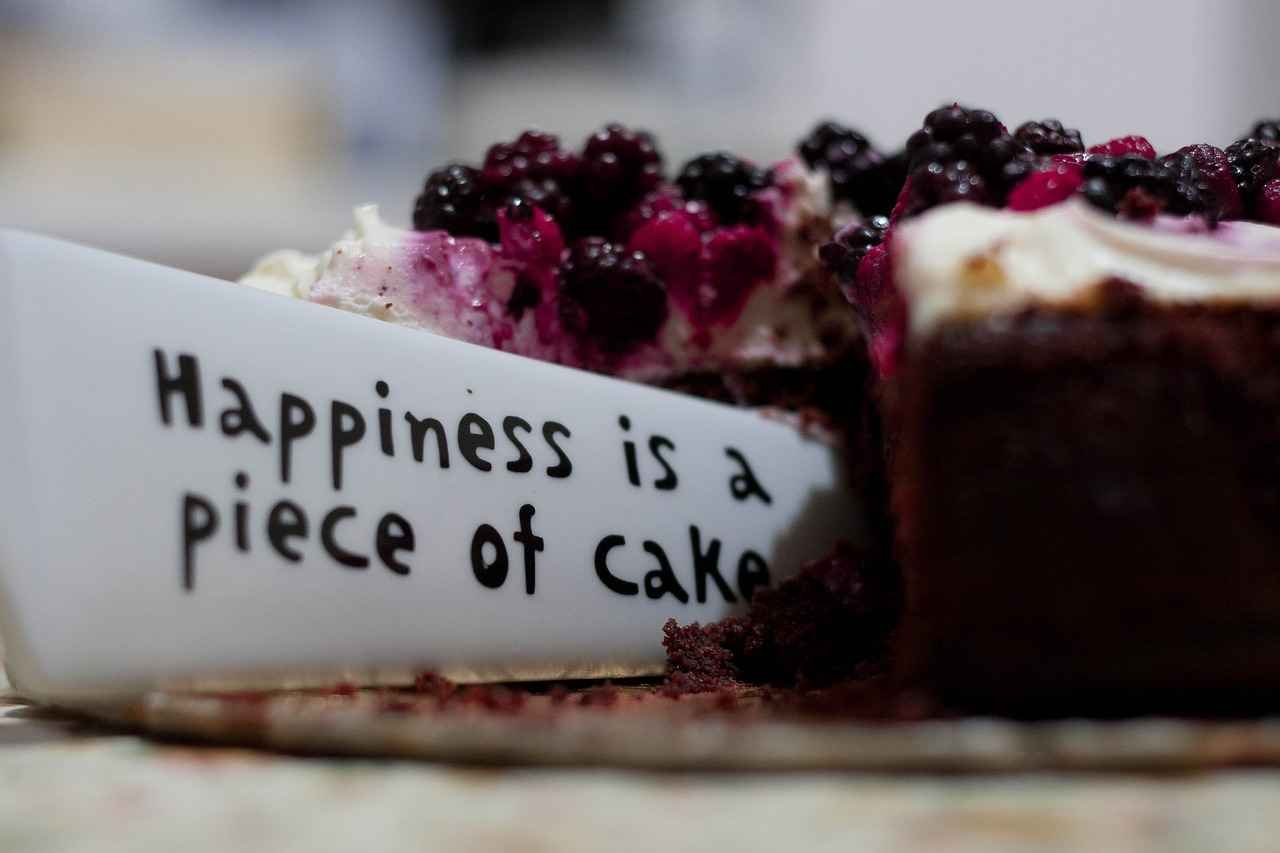21 HEART ATTACK frequently asked questions answered.

1. Heart attack vs anxiety or panic attack?
Heart attack happens when the arteries of the heart is blocked and the heart muscle gets damaged. Heart attack happens. The commonest symptom of heart attack is chest pain. Other associated symptoms are shortness of breath, palpitation, loss of consciousness etc.
Anxiety or panic attack happens when our thoughts hijack our senses so much that we are no longer capable of controlling them. Most of the time the patient can’t stop thinking about that un-necessary and exaggerated feeling. They het carried away and that negative thoughts can cause sudden rise in stress hormones. The stress hormones in excess give rise to high heart rate, palpitation, chest pain, shortness of breath and even loss of consciousness.
If the anxiety patient sits on a chair and starts taking steady and long breathing. He/she can try to do “box breathing” three to five times – inhale and count 4 to 1 – then hold and count 4 to 1 – exhale and count 4 to 1 – then inhale again and count 4 to 1.
Or
You can do diaphragmatic breathing means deep and long breathing. Scientific evidence shows it is effective in reducing stress, anxiety and negative affect. It does also reduce amount of stress hormones present in our blood.
Most of the anxiety and panic attack should terminate within a period of 10 minutes. But if the symptoms persist, rush to the hospital and take expert’s consultation at earliest.
Reference – https://www.ncbi.nlm.nih.gov/pmc/articles/PMC181226/

2. Heart attack or myocardial infarction –
Heart attack is myocardial infarction and vice vera. “Myo” means muscle, “cardial” means heart and “infarction” means death – so myocardial infarction means death of the heart muscle. It is the other name of heart attack.
Heart attack = Myocardial infarction.
3. Heart attack vs cardiac arrest
In heart attack the heart muscle gets damage in some way or the other. In cardiac arrest the electrical activity of the heart is interrupted. That leads to cardiac arrest. The heart attack is damage to the heart muscle itself. Heart muscles together act like a pump and pumps blood into our body and other vital organs. Heart attack as such may or may not lead to complete pump failure or cardiac arrest.
But if you stop the electrical supply of a pump – the pump will stop. As the pump will stop – it leads to complete stoppage of blood circulation in the body. If the circulation is stopped for more than 3 minutes the damage to the brain and other vital organs start. Sometimes heart regain its electrical activity and starts pumping again. If it does not the person dies.
Many people are trained with BLS and ACLS to do CPR and pumps the heart by compressing the chest manually.
So, heart in heart attack the heart muscle is damaged and the heart lose it’s mechanical power. In cardiac arrest the electrical supply to the heart muscle gets interrupted and the heart stops.
4. Heart attack vs heart block
Heart attack – what it is and how does it happen – I have already discussed in my other articles. Now “heart block” – I have seen patients using heart block for two types of issues. In one type the heart arteries were blocked due to atherosclerosis and clot formation inside the heart arteries. This leads to basically heart attack.
Another type is where the electrical system of the heart has lost its conduction to the heart muscle and chambers of the heart are failing to do their proper activities in proper sequence. Patient loses consciousness every now and then.
This often happens due to failure of electrical generators in the heart know as S.A. node and A.V. node (sinu-atrial node and atrio-ventricular node). More often than not an external pacemaker and electrical pulse generator is required in this situation.
5. heart attack vs heart failure –
Heart attack happens when due to some reason the heart muscle gets damaged.
Heart failure happens when the heart fails to pump the blood to the circulation either to the muscle weakness or increased stiffness of the heart muscle.
Heart attack may or may not lead to heart failure. Heart attack involving the large areas of the heart can lead to heart attack in the short term or in the long term.
Heart failure may or may not have any history of heart attack. Even their heart arteries may remain clean. Heart muscle may become weak due to many reasons.
The primary symptom of heart failure is shortness of breath and heart attack is chest pain.
6. Heart attack vs stroke –
Most commonly the heart attack happens due to the atherosclerotic plaque is causing block in the arteries and heart muscles die due to lack of oxygen and other supplies.
Stroke happens in the brain. It can happen mostly by two mechanism. The one that is similar to the heart attack is also caused by most commonly due to atherosclerosis.
The atherosclerosis block the arteries of the brain and the brain muscle starts dying. It takes 3 hours for the brain cells to die completely after which those cells will be replaced by other non-functional glial cells in the long term.
The symptom and signs of the patient depends on the area of the brain involved. Sudden onset weakness in the certain areas of the body, difficulty in talking, inability to control stool and micturition, loss of consciousness etc are very common signs of brain stroke.

7. Heart attack vs angina
Heart attack happens when the heart arteries are completely blocked and the heart muscle starts dying over a period of time. That is heart attack. Angina is when the heart arteries are not fully blocked, for instance, say they are blocked by 60%. When the person is at rest with 60% block most of the heart muscles are getting proper supply of oxygen and food.
So the person does not have the symptom. Now if the patient takes stairs or does some strenuous activities like running, swimming or weight lifting the heart muscles ask for more oxygen and food.
At that time the arteries can not do that with 60% block given the increased demand. So, patient feels pain and sometimes palpitation and sweating. This is known as angina.
Angina is mostly reversible. If the person takes rest for few minutes the heart rate settles, the supply demand gap vanishes and the patient feels better.
8. Heart attack vs muscle strain
If you have a muscle strain or muscle pain, mist probably you have a history of trauma. Means you know that when that part of muscle got injured. You should easily be remembering this.
The next thing about muscle strain or muscle pain is if you press the area you will feel the pain -means localized tenderness.
Heart attack pain cannot be localised by pressing on the area and neither heart attack has a history of trauma in that area.
If you use painkiller ointment most of these muscle strain or muscle pain subsides. Bit if you are still having pain on & off and you are not sure what it is – please visit your cardiologist.
9. Heart attack vs gas or acidity or heart burn
Heart attack symptom can mimic acidity or the symptom of heart burn. In acidity you have high secretion of acid inside your stomach and if that acidity reflux in to your food pipe (oesophagus), then it feels like a burning sensation inside the chest and we call it heart burn. As the food pipe lies just behind the heart and supplied by the same nerve (i.e. Vegas – the 10th cranial nerve) – the heart burn can be confused as the chest pain of the heart attack and vice versa.
The question here is what to do? If you are feeling heart burn take safe antacid syrups. If it is simple heart burn it should subside within 10 minutes or so. If not seek physician’s consultation and rush to the hospital.
If it gets relieved also, make sure you have a check-up and consultation for your acidity issue. Do not ignore it.
10. What is a “widow maker heart attack”?
Our heart has four chambers. The left sided chambers receive the blood with more oxygen and supply it to our body and its organ. The right sided chambers receive blood form the body and send it to the lung to add the oxygen from the air.
Now, as the left sided chamber specially the left ventricle has to pump out the blood to the whole body it works under more pressure than the right sided chambers and carry out a vital role in our circulation.
The artery that primarily supply this part of the heart is known as left anterior descending artery. If by any chance this artery is blocked in it’s origin the whole left ventricle becomes deprived of oxygen supply. The heart muscle dies and with it the pumping of the heart fails. The lungs then get filled with water due to heart failure. As the heart fails to pump blood to our vital organs the body and the person dies. This kind of heart attack is a killer. So that makes his wife a widow. That’s why it is known as “widow maker’s” heart attack.

11. Why heart attack causes left arm pain?
This is known as referred pain. In the mother’s womb we are built from a unicell to multicell and then multiorgan human being. When this development happens then there happens the overlapping of nerve supply.
This happens mostly due to the convergence of nerves supplying the skin and muscle and the heart into the same area in our spinal cord or the brain. So, the heart pain is also felt in the left arm.
Other examples for this disorder are the projection of cardiac pain in the left shoulder and arm: pain in the right shoulder, pain in gallbladder diseases, and back pain in peptic ulcer.
12. Can heart attack symptoms last of days or months?
Yes, heart attack symptoms easily last for days. It can last for first 3 weeks in on & off fashion.
But if you have received treatment for the heart attack and you are still having chest pain months after the heart attack – that is not normal. Consult your cardiologist as it may be a concern that you are still having angina or may be another heart attack,
13. How many heart attacks you can have?
You can have multiple heart attacks and survive. You can die also in any of the heart attack even in your first one. When any parts of our body get injured specially if it is muscle or bone – we can keep it in rest. But even after the heart attack even the heart muscle got damaged. The heart has to work constantly. That’s why the area of heart attack can increase up to 21 days of the heart attack if not treated immediately. Older people with multiple blocks usually survive more because their muscles are more conditioned to survive with lesser oxygen. But younger people with one or two recent blocks can die in their first attack as their heart muscle is not conditioned. The answer to the question is – you should prepare yourself having “zero” heart attack in your life span not at least before the age of 75 years.
14. What are the mini heart attack symptoms?
First thing, there is no such thing as “mini heart attack” – you are either have heart attack or not. The size of the heart attack may increase in size over a period of time. The mini heart attack can cause electrical problem in the heart and that if untreated can cause cardiac arrest and sudden death. So heart attack is heart attack – there is nothing as “mini”.
Symptoms remain the same in 90% –
- Chest pain,
- Shortness of breath,
- Palpitation,
- Dizziness,
- Loss of consciousness,
- Sweating,
- Nausea and vomiting ( more common in right side heart attack)
Rest of the 10% can have very mild symptom. More common in women, diabetic, elderly more than 75, past history of chest surgery, bypass surgery or trauma to the chest etc.
Remember heart attack is heart attack, It can kill you. The intensity of the symptom does not matter neither the initial size of the heart attack. So get medical attention at earliest.
15. Can heart attack happens at the age of 20 to 30 years ?
Yes it can happen in that age. Mostly the young heart attack happens due to extreme unhealthy habits, smoking, drug abuse and obesity.
16. What are the signs of silent heart attack?
Silent heart attack means – you are not having the chest pain but other symptoms are still present. These symptoms are –
- Sweating.
- Palpitation.
- Shortness of breath.
- Dizziness.
- Nausea and vomiting
- Loss of consciousness without any warning.
If you have any of these symptoms, consult your physician. Even if your heart attack is silent, it can be easily caught with very few simple tests in the blood tests, ECG and echocardiography.

17. What are the early signs of heart blockage?
The early signs of heart blockage is same as heart attack like –
- Chest pain.
- Shortness of breath & easy fatigue.
- Sweating.
- Palpitation.
- Dizziness.
- Loss of consciousness without any warning.
But these will not persist more than 10 minutes.
Mostly these will happen –
- after you exercise or
- take stairs or
- Had sex or
- Did heavy weight lifting or
- In a Mental stress or
- It can even happen after you have taken a heavy meal.
Be aware, if these symptoms happen on & off. It can come and go.
These are also preattack symptom for women, They are the warnings of a forthcoming bigger event. Sick medical advice and undergo a check up when the time is still in your hands.
18. How to clear blocked artery without surgery?
In cases where the atherosclerotic plaque is not the cause and only clotting of blood has caused the heart attack. In those cases only with medicines only heart arteries can be cleared. This happens in cocaine or some other frug abuse cases of heart attack. It also happens in some rare genetic issues. And it does not happen more than 1% cases of heart attack.
So most cases of heart attack, there is a mechanical block causes by atherosclerosis (most commonly) and it can never be treated without a heart surgery,
19. What percent blockage of a coronary artery is considered to be dangerous or what percent of blockage requires a stent?
Typically any blockage more than 70% in any heart artery is considered to be dangerous.
But if the main channel of the heart artery means “left main coronary artery” is blocked then 50% should be considered as dangerous.
Sometimes the block may be as low as 60% but it can produce effect like 70% blockade. This is measured by a technique known as “Functional flow reserve”.
Then the cardiologist may advice you to undergo surgery.
A procedure known as angiogram is necessary for this. And you may be advised with angioplasty and stent or CABG (bypass surgery) as per your requirements. It depends in the types, severity and location of the blocks.
20. Can you live with a 100 percent blocked artery?
Yes, a person can survive. This is known a “chronic total occlusion”. In theses cases one or two heart arteries are slowly blocked by 100% and the other healthy artery starts supplying blood to the affected region. The healthy artery by means of tiny vessels that normally connect one artery with the other, start providing blood and oxygen to the affected area. And thus the person survives.
21. How long a person can survive with blocked arteries?
In a research-based study where persons with triple vessel disease – means all three arteries have blockages – was followed up for a period of 15 years. 85% of them will survive after 5 years. And 50% of them died before the completion of the study.
If you have bypass surgery or stenting done you will have 10 to 15% more chances of survival over a period of 5 year and 15 years follow-up.
Conclusion –
Awareness about heart attack & related answered to the commonly asked questions will always help people. These are commonly asked questions by my OPD patients on daily basis. Here I have tried put some answers.





